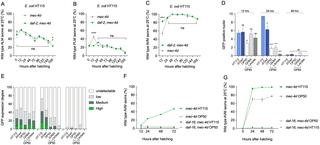PLOS Biology ( IF 7.8 ) Pub Date : 2020-03-24 , DOI: 10.1371/journal.pbio.3000638 Arles Urrutia 1, 2 , Víctor A García-Angulo 2, 3 , Andrés Fuentes 2 , Mauricio Caneo 1, 2 , Marcela Legüe 1, 2 , Sebastián Urquiza 2 , Scarlett E Delgado 1, 2 , Juan Ugalde 2 , Paula Burdisso 4 , Andrea Calixto 1, 2

|
Caenorhabditis elegans and its cognate bacterial diet comprise a reliable, widespread model to study diet and microbiota effects on host physiology. Nonetheless, how diet influences the rate at which neurons die remains largely unknown. A number of models have been used in C. elegans as surrogates for neurodegeneration. One of these is a C. elegans strain expressing a neurotoxic allele of the mechanosensory abnormality protein 4 (MEC-4d) degenerin/epithelial Na+ (DEG/ENaC) channel, which causes the progressive degeneration of the touch receptor neurons (TRNs). Using this model, our study evaluated the effect of various dietary bacteria on neurodegeneration dynamics. Although degeneration of TRNs was steady and completed at adulthood in the strain routinely used for C. elegans maintenance (Escherichia coli OP50), it was significantly reduced in environmental and other laboratory bacterial strains. Strikingly, neuroprotection reached more than 40% in the E. coli HT115 strain. HT115 protection was long lasting well into old age of animals and was not restricted to the TRNs. Small amounts of HT115 on OP50 bacteria as well as UV-killed HT115 were still sufficient to produce neuroprotection. Early growth of worms in HT115 protected neurons from degeneration during later growth in OP50. HT115 diet promoted the nuclear translocation of DAF-16 (ortholog of the FOXO family of transcription factors), a phenomenon previously reported to underlie neuroprotection caused by down-regulation of the insulin receptor in this system. Moreover, a daf-16 loss-of-function mutation abolishes HT115-driven neuroprotection. Comparative genomics, transcriptomics, and metabolomics approaches pinpointed the neurotransmitter γ-aminobutyric acid (GABA) and lactate as metabolites differentially produced between E. coli HT115 and OP50. HT115 mutant lacking glutamate decarboxylase enzyme genes (gad), which catalyze the conversion of GABA from glutamate, lost the ability to produce GABA and also to stop neurodegeneration. Moreover, in situ GABA supplementation or heterologous expression of glutamate decarboxylase in E. coli OP50 conferred neuroprotective activity to this strain. Specific C. elegans GABA transporters and receptors were required for full HT115-mediated neuroprotection. Additionally, lactate supplementation also increased anterior ventral microtubule (AVM) neuron survival in OP50. Together, these results demonstrate that bacterially produced GABA and other metabolites exert an effect of neuroprotection in the host, highlighting the role of neuroactive compounds of the diet in nervous system homeostasis.
中文翻译:

细菌产生的代谢物可保护秀丽隐杆线虫神经元免于退化。
秀丽隐杆线虫及其同源细菌饮食构成了研究饮食和微生物群对宿主生理学影响的可靠且广泛的模型。尽管如此,饮食如何影响神经元死亡的速度仍然很大程度上未知。 C中使用了许多模型。线虫作为神经退行性疾病的替代品。其中之一是C 。表达机械感觉异常蛋白 4 (MEC-4d) 变性蛋白/上皮 Na + (DEG/ENaC) 通道神经毒性等位基因的线虫菌株,可导致触觉感受器神经元 (TRN) 进行性变性。使用这个模型,我们的研究评估了各种饮食细菌对神经退行性变动态的影响。尽管在常规用于C的菌株中,TRN 的退化是稳定的并且在成年时完成。线虫维持(大肠杆菌OP50),它在环境和其他实验室菌株中显着减少。引人注目的是,大肠杆菌中的神经保护作用达到了 40% 以上。大肠杆菌HT115 菌株。 HT115 保护作用可以长期持续到动物老年,并且不限于 TRN。 OP50 细菌上的少量 HT115 以及紫外线灭活的 HT115 仍然足以产生神经保护作用。 HT115 中线虫的早期生长可保护 OP50 中神经元在后期生长过程中免于退化。 HT115 饮食促进了 DAF-16(FOXO 转录因子家族的直系同源物)的核易位,此前报道这种现象是该系统中胰岛素受体下调引起的神经保护的基础。 此外, daf-16功能丧失突变消除了 HT115 驱动的神经保护作用。比较基因组学、转录组学和代谢组学方法确定了神经递质 γ-氨基丁酸 (GABA) 和乳酸是大肠杆菌之间产生的差异代谢物。大肠杆菌HT115 和 OP50。 HT115突变体缺乏谷氨酸脱羧酶基因( gad ),该酶催化谷氨酸转化为GABA,失去了产生GABA的能力,也失去了阻止神经退行性变的能力。此外,原位 GABA 补充或大肠杆菌中谷氨酸脱羧酶的异源表达。大肠杆菌OP50 赋予该菌株神经保护活性。具体C.线虫GABA 转运蛋白和受体是 HT115 介导的完整神经保护所必需的。此外,补充乳酸还可以增加 OP50 中前腹侧微管 (AVM) 神经元的存活率。总之,这些结果表明细菌产生的 GABA 和其他代谢物对宿主具有神经保护作用,突出了饮食中的神经活性化合物在神经系统稳态中的作用。











































 京公网安备 11010802027423号
京公网安备 11010802027423号